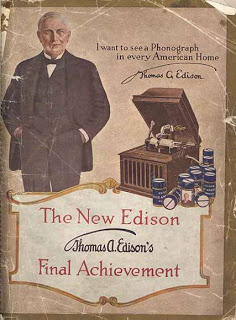 |
| Image courtesy loc.gov |
On February 19, 1878, Thomas Edison officially patented the phonograph, thereby changing the music listening habits of people everywhere. The first notes that rang out from the bell? Mary Had a Little Lamb!
Edison came upon the phonograph while working on improvements to the telegraph and telephone. The machine was marketed first as a talking machine, but by the late 1880s, pre-recorded music became the phonograph’s main use. The machine had two needles: one for recording and one for playback. Originally, the phonograph recorded sounds on tin foil, but later wax cylinders replaced the foil as the recording medium. The cylinder went out of style soon after the turn of the century when the industry switched to discs, and the phonograph morphed into what we know as a record player.
You can find images of Edison phonographs as well as digital recordings from wax cylinders in the digital library Europeana. The Library of Congress American Memory collection on the Edison Company also has a great collection of early 20th century disc phonograph recordings. A fun highlight is this silent film advertisement for the business dictation phonograph.
The sound was not as clear as today’s stereo speakers, but the phonograph provided a home listening experience. When the first tape cassettes were introduced in the 1960s, the phonograph’s dominance in home audio listening and recording began its decline.
For more information in the library collection, check out Music, Sound, and Technology in America: A Documentary History of Early Phonograph, Cinema, and Radio or Recorded Music in American Life: The Phonograph and Popular Member, 1890-1945.
—Madalyn Muncy, Library Student Blogger